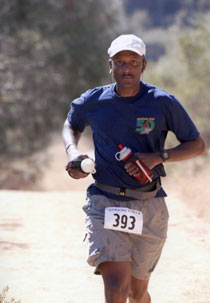
Handy Links
SLAC News Center
SLAC Today
- Subscribe
- Archives: Feb 2006-May 20, 2011
- Archives: May 23, 2011 and later
- Submit Feedback or Story Ideas
- About SLAC Today
SLAC News
Lab News
- Interactions
- Lightsources.org
- ILC NewsLine
- Int'l Science Grid This Week
- Fermilab Today
- Berkeley Lab News
- @brookhaven TODAY
- DOE Pulse
- CERN Courier
- DESY inForm
- US / LHC
SLAC Links
- Emergency
- Safety
- Policy Repository
- Site Entry Form

- Site Maps
- M & O Review
- Computing Status & Calendar
- SLAC Colloquium
- SLACspeak
- SLACspace
- SLAC Logo
- Café Menu
- Flea Market
- Web E-mail
- Marguerite Shuttle
- Discount Commuter Passes
-
Award Reporting Form
- SPIRES
- SciDoc
- Activity Groups
- Library
Stanford
Around the Bay
No Mountain High Enough
 Last weekend, Milo Lewis, the materials coordinator for Stanford's Synchrotron Radiation Laboratory, ran a marathon. He also ran a marathon the weekend before that, and the weekend before that—for him, 26.2 miles is just another day of training. Since 1984, 54-yeard old Lewis has been competing in "ultra-marathons," racing distances as long as 100 miles.
Last weekend, Milo Lewis, the materials coordinator for Stanford's Synchrotron Radiation Laboratory, ran a marathon. He also ran a marathon the weekend before that, and the weekend before that—for him, 26.2 miles is just another day of training. Since 1984, 54-yeard old Lewis has been competing in "ultra-marathons," racing distances as long as 100 miles.
Lewis started running marathons with the US Marine Corps race team in 1976. In 1984, a friend convinced him to compete in the 50-mile American River run. "I couldn't believe they even had races that long," Lewis recalled. "But I did it, and I didn't want to stop. So in 1986 I did my first 100 and fell in love."
Lewis has now successfully completed ten 100-mile races, and countless 50-milers and marathons. "These ultra-marathons, it's not all about conditioning. It's about mental toughness as well," Lewis explained. "They take between 24 and 30 hours, so you're out there all day and all night. You've got to navigate through a lot of adversity."
For Lewis, the appeal of ultra-distance running is not only in the challenge. "The best part about it is the camaraderie," he said. "The people around you aren't selfish—they'll sacrifice their time to help you get to the finish line. That wouldn't happen with a marathon. Marathons are all about speed, and each man for himself. Ultra-distance running is like being in the military. You're a band of brothers, and you stay together."
Not to be constrained by just one inconceivable activity, Lewis also competes in ultra-distance cycling—200 mile bike races. He has completed 14 such races, including two California triple crowns, which each consists of three 200-mile events in a single year. He has also completed seven California Death Rides—129 miles with 16,000 feet of climbing.
Lewis's training regimen includes 70 miles of running and 50 miles of biking every week, along with frequent weight training at the gym. One of Lewis's training partners is his longtime friend Dieter Walz—a 72-year-old Engineering Physicist at SLAC. "He's an incredible person," said Lewis. "I really admire him—when I grow up, I want to be just like him. I want to teach my grandchildren that when you get to a certain age, you don't start going downhill unless you choose to go downhill."
Lewis's next major challenge will be the world's most renowned ultramarathon—the Western States Endurance Run. In this grueling 100-mile race, an elite group of runners ascend the Sierra Nevadas from the floor of Squaw Valley, climbing 18,000 feet of remote, rugged trails before descending 23,000 feet to Auburn, California. "You can run through snow and 110-degree heat in the same day," Lewis said. "It's the most intense thing you can do. I always tell people—to test your endurance, do an Iron Man. To test your soul, you must run Western States."
—Elizabeth Buchen, SLAC Today, December 12, 2007